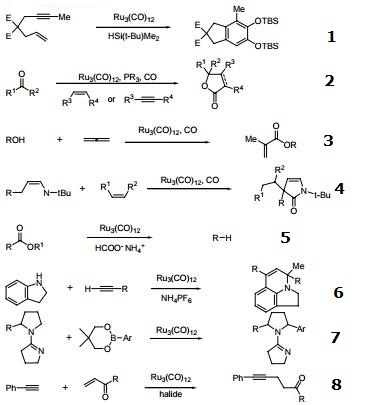Triruthenium dodecacarbonyl is a metal carbonyl complex, classified as an inorganic compound. Its molecular formula is Ru3(CO)12, with a molecular weight of 639.33. It possesses D3h symmetry and a core composed of a Ru equilateral triangle. Each Ru atom is attached to two axial and two equatorial CO ligands. Unlike triiron dodecacarbonyl, this compound does not contain any bridge bonds. It is commonly employed as a precursor for various organoruthenium compounds.
The substance appears as orange plates or powder and is soluble in non-polar organic solvents.
Ruthenium carbonyl is a H-transfer catalyst. It is used in carbonylation catalysis of the allylic amination of unactivated olefins by nitroarenes, reductive carbonylation of mononitro aromatic compounds to carbamates, and as a catalyst for cycloaddition reactions. It is employed as a precursor for the synthesis of Ru nanoparticles. Catalyst used in the intermolecular [3+2+1] cycloaddition of alpha,beta-unsaturated ketones with silylacetylenes and carbon monoxide, to produce alpha-pyrones. Catalyzes the coupling of silanes with thiols, alcohols and amines with high turnover number (TON) and high turnover frequency (TOF).
-
Catalyst for the conversion of enynes to catechol derivatives.
-
Catalyst for the intermolecular [2+2+1] cycloaddition of ketones, CO and alkenes or alkynes.
-
3-Component couplings.
-
Reaction of α,β-unsaturated imines with carbon monoxide and alkenes to form β,γ-unsaturated γ-butyroactams.
-
Ester decarboxylation.
-
Catalyst for hydroamination and C-H bond activation.
-
Used in sp3 C-H bond arylation and carbonylation.
-
Ru/halide catalytic system for C-C bond forming reaction between alkynes and unsaturated carbonyl compounds.
-
Amination of α-hydroxy amides.


Atomic number of base material: 44 Ruthenium
core: ruthenium
reaction type: C-H Activation
reagent type: catalyst





